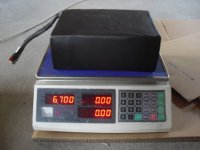cwah
100 MW
dogman said:Say your $450 of lipo lasted 400 cycles, that's more than double ( $1.25) the $.50 per cycle my first ping cost. Add another $150 for lipo chargers, and you reach about $1.50 per cycle. That first ping had the 1c cells, and the chargers have improved so chances are the cost per cycle is not so much different given the current price of a new ping. Assuming you got 700 cycles from a new 48v 15 ah ping, the cost is closer to a buck a cycle than fifty cents. But still perhaps at least 30-50 cents per cycle cheaper than lipo, and that includes the price of the charger, when the lipo calculation did not.
I agree in term of pure number of lifecycle lifepo4 is largely winner.
But if you do the math in term of usage (and not number of cycle), if we consider you do about 200 cycles a year, a lipo would last 2 years. And with 2 lipo would can end up using it for 4 years. I don't have the data about Lifepo4 shelf life, but I suppose we could agree that after 4 years it's time to change battery.
If you get a lifepo4 48V15AH (720Wh) with ping:
http://www.pingbattery.com/servlet/Cart?cart_id=24782801
- Weight: 7.5kg
- 485$ battery + 119$ shipping (to uk)= 604$ total cost.
If you get 3s*2p (zippy 6S1P at 5AH) you have a pack of 44.4V15AH (666WH)
http://www.hobbyking.com/hobbyking/store/__8582__ZIPPY_Flightmax_5000mAh_6S1P_20C_.html
- Weight: 6*0.844g= 5.06kg
- 296.88$ batteries + 85.15 shipping (to uk) = 382.03$ total cost the first 2 years.
- 382.03 * 2 = 764.06$ total cost the next 2 years. (And this total assume that the lipo price remains the same 2 years later)
Ok, at the end you would have lost around 150$. And you also have to pay for additional charger. But you have a weight advantage, you can swap your lipo when needed and after 2 years you have brand new batteries. Also, we should consider that the technology evolve and after 2 years we will probably have better performing batteries.
What do you think of this calculation? Do you expect to use your lifepo4 for more than 4 years? Don't forget that batteries loose its capacity over years naturally (shelf life), so most likely the battery is not going to have much capacity after several hundred of cycles + 4 years in the belt.




